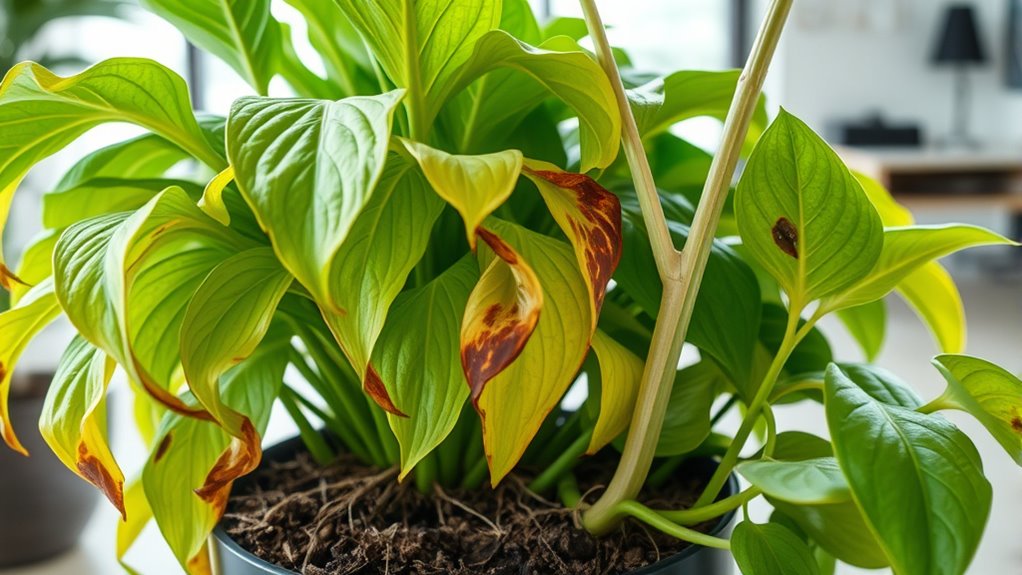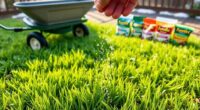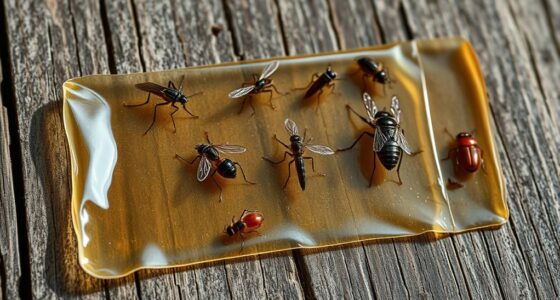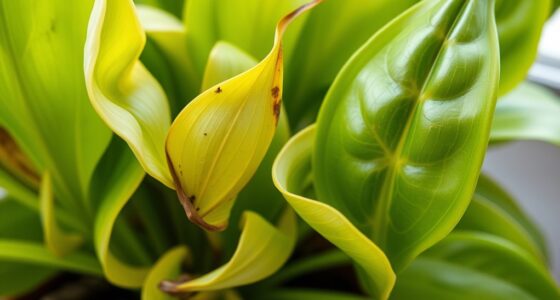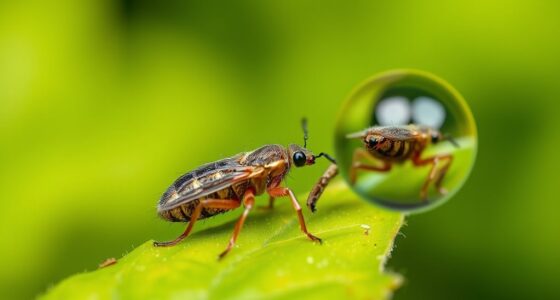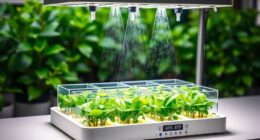If you’re wondering what’s wrong with your plant, look for key signs like yellowing leaves, wilting, or brown edges, which can indicate watering problems or nutrient deficiencies. Check for pests such as tiny bugs or webbing, and observe if soil feels soggy or dry. Spot leaf spots or mold, which hint at fungal issues. By observing these signs closely, you’ll identify common problems and learn how to fix them effectively. Keep exploring for more solution tips.
Key Takeaways
- Observe leaf coloration, spots, or wilting to identify pests, diseases, or watering issues.
- Check soil moisture; soggy indicates overwatering, dry suggests underwatering.
- Look for signs of pests like webbing, sticky residue, or tiny bugs on leaves and stems.
- Note changes in leaf texture, color, or growth patterns to detect fungal or bacterial problems.
- Regularly inspect the plant and environment to catch issues early and adjust care accordingly.

Plants often show signs of trouble before serious damage occurs, so recognizing common problems early is key to keeping them healthy. One of the first issues you might notice involves watering problems. Overwatering can cause leaves to yellow, stems to become soft, and roots to rot. On the other hand, underwatering leads to wilting, dry soil, and brown leaf edges. To diagnose watering issues, check the soil’s moisture level. If it feels soggy, hold back on watering and let the soil dry out slightly. If it’s bone dry, give your plant a thorough soak and monitor how quickly the soil dries out afterward. Adjust your watering schedule based on the plant’s specific needs, season, and environment. Proper watering is essential, and missteps here often mimic other problems, so paying close attention to soil moisture is a simple but effective first step. Additionally, understanding a plant’s specific tuning needs can help prevent and address issues more effectively.
Beyond watering, pest identification is key in diagnosing plant health issues. Small insects like aphids, spider mites, or mealybugs can cause significant damage if left unchecked. They often feed on the plant’s sap, weakening stems and leaves, which can lead to discoloration, deformities, or stunted growth. You might notice sticky residue (honeydew), webbing, or tiny moving specks on your plant. Regularly inspecting your plant’s underside of leaves, stems, and soil surface can help you catch pests early. If you find pests, act quickly by removing them manually or applying insecticidal soap. Recognizing pest signs early prevents infestations from spreading and causing irreversible damage.
In addition to watering issues and pests, other common problems include leaf spots, which may indicate fungal or bacterial infections, and yellowing leaves that could be a sign of nutrient deficiencies or improper light. Each symptom points to specific causes, so it’s essential to observe your plant closely. Take note of changes in leaf color, texture, or growth patterns, and compare them to known issues. A combination of poor watering practices and pest problems often worsens a plant’s condition, so addressing both promptly is key.
Frequently Asked Questions
How Often Should I Water My Indoor Plant?
You should water your indoor plant based on its specific needs, but generally, follow a consistent watering schedule—usually once a week. Check the soil moisture regularly; wait until the top inch feels dry before watering again. Keep an eye on humidity levels, as higher humidity may reduce watering frequency. Adjust your schedule accordingly, ensuring your plant isn’t over or underwatered, promoting healthy growth and vibrant foliage.
What Soil Type Is Best for Succulents?
You should use well-draining soil for succulents to prevent waterlogging and root rot. Look for a mix that offers excellent soil drainage, such as one with sand or perlite, to keep excess water away from roots. Additionally, choose a soil that meets the nutrient requirements of succulents, providing essential minerals without holding too much moisture, ensuring healthy growth and vibrant plants.
How Can I Prevent Pests on My Houseplants?
To prevent pests on your houseplants, start with natural pest control methods like introducing beneficial insects or using neem oil. Always inspect new plants carefully and practice plant quarantine before placing them with your existing ones. Keep your plants healthy by providing proper watering and lighting, which makes them less attractive to pests. Regularly check for early signs of trouble, and act quickly to keep pests at bay.
When Should I Repot My Flowering Plant?
Repotting your flowering plant is like giving it a growth spurt—timing is key. You should consider repotting when it outgrows its current container, showing roots through the drainage holes, or if the soil looks depleted. Typically, follow a repotting schedule of every 1-2 years, depending on plant size. If your plant’s root system is crowded, it’s time to upgrade to a slightly larger pot for healthy growth.
Why Are My Plant’S Leaves Turning Yellow?
If your plant’s leaves are turning yellow, it’s often due to leaf discoloration caused by a nutrient deficiency. You might notice the yellowing starting at the tips or edges, signaling your plant isn’t getting enough essential nutrients like nitrogen. To fix this, consider fertilizing with a balanced, water-soluble fertilizer and make certain you’re not overwatering, which can also cause yellow leaves by affecting nutrient uptake.
Conclusion
Don’t let your plant’s problems leave you feeling helpless. With a little attention and the right diagnosis, you can revive even the most wilting plants. Imagine walking into your home and seeing your healthy, vibrant plant thriving again—it’s within your reach. Just like caring for a friend, your plant needs your observation and love. So, grab your tools, trust your instincts, and watch your green friend flourish once more.
